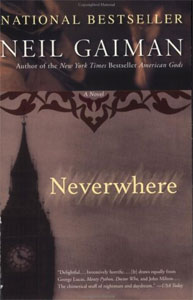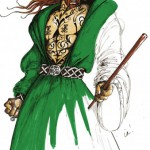Neverewhere by Neil Gaiman
Neil Gaiman’s Neverwhere, the novelization of the 1996 BBC Two show by the same name, follows exactly the plot of the TV show, but allows Gaiman to expand on certain elements and correct changes made by the series, which he also wrote. While I have never seen the television series, or for that matter read the graphic novel which followed the novel, my very first thought upon finishing the book was, “This would better translate visually.” That thought came to me before I even knew that it had already and would subsequently be portrayed in visual medias. However, this is a thought I usually have with Neil Gaiman. I love his books, but I tend to like his work better when its not done in written form.
I was initially introduced to Gaiman’s work through his Sandman graphic novels and fell in love with the dark style and interchangeability of mythos and “reality”. Intrigued by his style, I thought that perhaps I should read some of his novels. I knew quite a few fans of his, and I picked up Neverwhere. After following Richard Mayhew through his boring life for a bit, we discover with him a girl, bleeding and weak, on the street. Despite Richard’s fiancee’s protestations that the girl is none of his business and they’ll be late for an influential dinner with her boss, Richard does something out of the ordinary. Instead of bending to the will of his fiancee, he decides to help the girl, and he brings her back to his apartment.
This one act sets everything Richard thought he knew into complete disarray. After being sent out by the girl, whose name we find out is Door, to find the Marquis de Carabas, he discovers that he essentially no longer exists to those around him. For lack of a better word, he’s invisible. By rescuing Door he unexpectedly stepped out of his reality and into a parallel but very different one in London Below. This is a place where names actually indicate reality. For example, Earl’s Court in London Below has the actual Earl presiding. With that said, the book itself probably has a little more meaning or significance if you pull out a map of London. Had I not already been there before reading this story, the places and names would have been somewhat lost on me. Perhaps you wouldn’t lose anything by not getting all of the geographical references, but I felt that had I not known, I might have thought it was all a little hokey.
Overall, some parts of the action seemed a bit rushed, and other parts felt like they dragged a bit. It was a fairly decent read and good if you don’t really want to take the book too seriously and just enjoy yourself. Neil Gaiman has a gift, and reading this book it makes you realize that it’s not necessarily for writing novels. I couldn’t help thinking the whole time I was reading this that the narrative seemed better suited to a graphic novel. Lo and behold, shortly after I initially read the book, it did indeed come out in a graphic novel.
My opinions may very well be biased from reading Sandman beforehand, so I’ll accept all criticism to that end. However as a work of urban fantasy, I would say this is a fairly good example. It certainly exemplifies the sub genre. If you are already a fan of Neil Gaiman’s books, then it would stand to reason that you would also like this one. I won’t even go so far as to say I didn’t like it, but it left me wanting something else, something more. I think Neil Gaiman is certainly on the right path, but this probably isn’t the best example of his “art”.
“I’d watch out for doors if I was you.”







